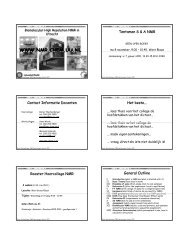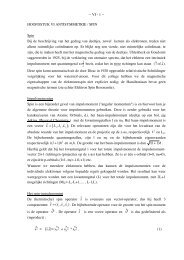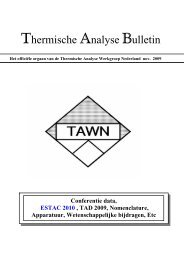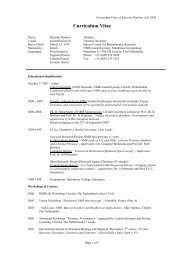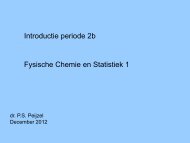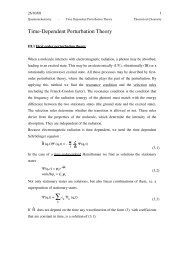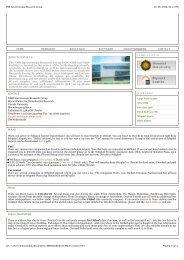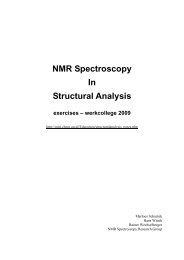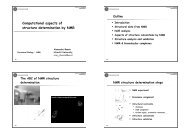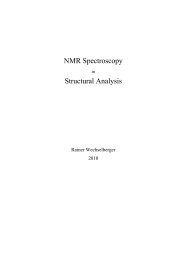Reader Angular Momentum
Reader Angular Momentum
Reader Angular Momentum
Create successful ePaper yourself
Turn your PDF publications into a flip-book with our unique Google optimized e-Paper software.
26/10/08 1Quantumchemistry - <strong>Angular</strong> Momenta Theoretical Chemistry<strong>Angular</strong> MomentaII.1Constants of the motionA constant of the motion is an observable with a time-independent expectation value,like the energy. It may be proven that this is the case if the corresponding (Hermitian)operator commutes with the Hamiltonian. Constants of the motion are used forcharacterising stationary states.For a stationary state! = "e #iEt / ! (2.1)the energy does not depend on t, since for a time-independent Hamiltonian H we have(assuming that Φ is normalised) :andˆ H ! = E! (2.2)< !e "iEt / ! | H | !e "iEt / ! >= # e iEt / ! !* E!e "iEt / ! dq = E # !*!dq = E (2.3a)If ˆ A commutes with ˆ H , ˆ A and ˆ H have a common set of eigenfunctions. Theseeigenfunctions then have the same time dependence and therefore in (2.3a) ˆ H may bereplaced by ˆ A :< !e "iEt / ! | A | !e "iEt / ! >= # e iEt / ! !* A!e "iEt / ! dq = a # !*!dq = a (2.3b)where a is the eigenvalue of ˆ A .Sine ˆ A en ˆ H have a common set of eigenfunctions, the properties (eigenvalues) w.r.t. ˆ Amay be used in order to characterise the stationary states, since eigenfunctions of ˆ A withdifferent eigenvalues (for ˆ A ) do not interact. Thus ifwe haveˆ A ! 1= a 1! 1ˆ A ! 2= a 2! 2a 1" a 2(2.4a)< ! 1| H | ! 2>= 0 (2.4b)Two examples are spatial symmetry and electron spin.
26/10/08 2Quantumchemistry - <strong>Angular</strong> Momenta Theoretical ChemistryExercise 2.1If ˆ A and ˆ H Hermitian, [ ˆ A , ˆ H ] = 0, ˆ A Φ 1 = a 1 Φ 1 , ˆ A Φ 2 = a 2 Φ 2 and a 1 ≠ a 2 , prove that< Φ 1 | H | Φ 2 > = 0.Hint : Evaluate < Φ 1 | HA | Φ 2 > and use < f 1 | f 2 > = < f 2 | f 1 >*.Comment : if you want to use < Φ 1 | HA | Φ 2 > = < Φ 2 | HA | Φ 1 >*, you first have toprove that this is true (you need the fact that ˆ A and ˆ H commute).Spatial symmetryIn a diatomic molecule AB we have (the z axis is the internuclear axis) :[ ˆ ! xz, H ˆ (AB)] = [ ˆ ! ˆyzH (AB)] = 0, (2.5)where [ ˆ ! xz, represents the reflection w.r.t. the xz plane. The commutation is caused bythe fact that the (electronic) Hamiltonian for AB does not change if y is replaced by –y.If we haveˆ ! xz" 1= " 1(2.6)ˆ ! xz" 2= #" 2the first function in (2.6) is symmetrical w.r.t. the reflection, whereas the second functionis antisymmetrical. The difference in the symmetry properties appears from thedifference in the eigenvalues w.r.t. the symmetry operator. This is an example of (2.4)Exercise 2.2Prove the invariance of ˆ H (AB) under ˆ ! xz,.Hint : in the new coordinate system the nuclear coordinates still have the same values.
26/10/08 3Quantumchemistry - <strong>Angular</strong> Momenta Theoretical ChemistryFig 2.1 The block diagonal form for the H-matrix for a 2-electron system.Electron spin[ ˆ H , ˆ S 2 ] = [ ˆ H , ˆ S z] = 0 if ˆ H does not contain any spin operator. Therefore theeigenfunctions of ˆ H should also be eigenfunctions of ˆ S 2 and ˆ S z. The reverse does nothold : an eigenfunction of ˆ S 2 does not have to be an eigenfunction of ˆ H . All functionswhich are degenerate with respect to ˆ S 2 (which have the same S value) have to be takentogether (linearly combined) in order to get an eigenfunction of H ˆ . However, of these S ˆ 2eigenfunctions, only the functions with the same M S value belong together, sincefunctions with different M S values do not interact either.The result is the block diagonal form of the H-matrix as shown in Fig 2.1. For each blockthe eigenvalues may be found by a separate calculation.This case is in fact a special case of the use of angular momentum operators. In thefollowing the general properies of angular momentum operators will be discussed.
26/10/08 4Quantumchemistry - <strong>Angular</strong> Momenta Theoretical ChemistryII.2 The angular momentum operatorsThe classical expression for the kinetic energy for rotations is given by :withT rot= L22I(2.7a)2I = ! m ir ii(2.7b)Here L is the (rotational) angular momentum vector, I is the moment of inertia, r i is thedistance from the center-of-mass, andL = r ! PL x= yP z" zP y(2.8)L y= zP x" xP zL z= xP y" yP xThe operator for L is found by replacing p x ,p y and p z by the corresponding operators. Theresult is :L = (L x,L y,L z)(2.9a)withL x= yP z! zP yL y= zP x! xP z(2.9b)whereandL z= xP y! yP xP x= ! ! i""xetc.L 2 = L 2 x+ L 2 2y+ L z(2.9c)(2.9d)Using (2.9) in (2.7a) yields the expression for the kinetic energy operator of a rotatingmolecule (the internal coordinates are assumed to be fixed). By solving the differentialequations (i.e. the eigenvalue problem) associated with (27a) the spherical harmonics arefound (i.e. the angular factors in the H-atom AOs).
26/10/08 5Quantumchemistry - <strong>Angular</strong> Momenta Theoretical ChemistryHowever, L may be used in many more circumstances. Moreover, the eigenvalues maybe derived directly from the commutator properties of L 2 and the components of L,without solving any differential equations. In the following the commutation propertiesof the angular momentum operators will be discussed.II.3 Commutation propertiesWe start with the angular momentum for one particle. The corresponding operator isdenoted by l. The commutation properties of the components of l with each other andwith l 2 are essential for the calculation of the eigenvalues.We start with the commutation rule for position and (linear) momentum (atomic unitswill be used throughout) :[x,p x ] = [y,p y ] = [z,p z ] = i (2.10)and :[x,p y ] = [x,p z ] = [y,p x ] = [y,p z ] = [z,p x ] = [z,p y ] = 0 (2.11)Using (2.9) we obtain the commutator for l x and l y :[l x ,l y ] = [yp z − zp y , zp x − xp z ] == [yp z , zp x ] − [yp z , xp z ] − [zp y , zp x ] + [zp y , xp z ] (2.12)Further evaluation yields :[yp z , zp x ] = yp z zp x – zp x yp z = yp x [ p z z – z p z ] = −iyp x[yp z , xp z ] = [zp y , zp x ] = 0 (2.13)[zp y , xp z ] = zp y xp z – xp z zp y = xp y [zp z –p z z] = ixp yCombining these results we have :[l x , l y ] = i(xp y – yp x ) = il z (2.14a)For the other components we find analogously :[l y , l z ] = i(yp z – zp y ) = il x (2.14b)[l z , l x ] = i(zp x – xp z ) = il y (2.14c)Finally it may be proven in the same way that :[l 2 , l x ] = [l 2 , l y ] = [l 2 , l z ] = 0 (2.15)
26/10/08 6Quantumchemistry - <strong>Angular</strong> Momenta Theoretical ChemistryExercise 2.3Prove (2.15).Hint : first show that [A 2 ,B] = A[A,B] + [A,B]A for any pair of operators A and B.In the following an angular momentum operator will be defined as any operatorwith these commutation properties, (2.14) and (2.15). The definitions (2.9) in terms ofx,y,z,p x ,p y en p z will not be needed anymore.Since l 2 and l x commute, they have a common set of eigenvectors. This also holds for l 2and l y , and for l 2 and l z . However, l x and l y do not commute and therefore they do not havethe same eigenvectors. This is possible if all eigenfunctions of l 2 are degenerate. In thiscase arbitrary linear combinations of the eigenfunctions of l 2 are still eigenfunctions of l 2with the same eigenvalue. The common set of eigenfunctions for l 2 and l x then containslinear combinations which are different from the common set of eigenfunctions for l 2 andl y . Only one component of l may be chosen in order to characterise the eigenfunctions ofl 2 . Usually l z is used for this purpose.II.4 Shift operatorsThe following notation will be used :|λ m > is an eigenfunction of l 2 and l z with eigenvalues λ and m respectively.Definition : If a shift operator acts on an eigenfunction, a new eigenfunction with adifferent eigenvalue is generated.We consider the operatorl + = l x + il y (2.16)We need the commutator for l z and l + :[l z ,l + ] = [l z , l x +il y ] = il y + i (−il x ) = l + (2.17)and this yields :l z (l + |λ m >) = (l z l + − l + l z + l + l z ) | λ m > == ( [l z ,l + ] + l + l z ) | λ m > = l + (1 + l z ) | λ m > == l + (1 + m) | λ m > = (m + 1) (l + | λ m >) (2.18)
26/10/08 7Quantumchemistry - <strong>Angular</strong> Momenta Theoretical ChemistryFrom (2.18) we conclude that l + generates a new eigenfunction of l z with eigenvaluem+1. Since l + commutes with with l 2 , the new function is still an eigenfunction of l 2 witheigenvalue λ.Analogously the operatorl − = l x − il y (2.19)leads tol z (l − |λ m >) = (m − 1) (l − | λ m >) (2.20)However, note that the shift operators do not generate normalised functions :L ± | λ m > = c ± | λ m ±1 > (2.21).where c ± depends on the values of λ and m.These two shift operators are now used in order to calculate the eigenvalues of l z and l 2 .II.5 The eigenvalues of l z and l 2The definitions of the shift operators yield :l − l + = l 2 – l z (l z +1)l + l − = l 2 – l z (l z −1)l 2 = 1 2 (l l + l l ) + l 2! + + ! z(2.22a)(2.22b)(2.22c)and from this we obtain :Therefore :< λ m | l − l + | λ m > = < λ m | l 2 – l z (l z +1) | λ m > = λ − m (m+1) (2.23a)< λ m | l + l − | λ m > = < λ m | l 2 – l z (l z −1) | λ m > = λ − m (m−1) (2.23b)12 < !m | l + l " + l " l + | !m >=< !m | l 2 " l z 2 | !m >= ! " m 2 (2.24a)< λ m | l 2 – l z 2 | λ m > = < λ m | l x 2 + l y 2 | λ m > ≥ 0 (2.24b)λ – m 2 ≥ 0(2.24c)Exercise 2.4Prove (2.24b)
26/10/08 8Quantumchemistry - <strong>Angular</strong> Momenta Theoretical ChemistryWe conclude that the “ladders” are finite. For the maximal value m = m + we have :l + | λ m + > = 0(2.25a)and for the minimal value m = m − :l − | λ m − > = 0(2.25b)Using (2.23) then yields :< λ m + | l − l + | λ m + > = 0 = λ – m + (m + + 1) (2.26a)< λ m − | l + l − | λ m − > = 0 = λ – m − (m − − 1) (2.26b)The conditions (2.26) are satisfied by m = − m + and λ = m + (m + + 1). In the following m +is denoted by l and this is the quantum number determining the l 2 eigenvalue λ = l(l+1).All l z eigenfunctions have the same l 2 eigenvalue λ. In the following the eigenfunctionsof l 2 will be denoted by |l m >. The set of all eigenfunctions |l m > with –l ≤ m ≤ lcontains 2l + 1 functions and together they are called a multiplet.Exercise 2.5The conditions (2.26) are solved by using the equation : m − (m − − 1) = m + (m + + 1)Since this is a quadratic equation, there must be a second solution. Why does thissolution not work in practice ?II.6Coupling of angular momentaIn the following the construction of eigenfunctions and the calculation of thecorresponding eigenvalues for combinations of angular momenta will be discussed. Thismay concern angular momenta for two particles or the combination of different kinds ofangular momenta, e.g. orbital and spin angular momenta. Some examples are :a) Orbital angular momentum for N-electron wave functions.b) Spinfunctions for N electrons.c) Spinfunctions for the nuclei.d) Spin-orbit interaction.e) Couplings between rotations of different moleculs.For all these cases the same technique may be used.
26/10/08 9Quantumchemistry - <strong>Angular</strong> Momenta Theoretical ChemistryClassically we have :L(1,2) =L (1)+ L(2) (2.27)Therefore the angular momentum operators are obtained by :L = l 1 + l 2 (2.28)It may be proven that L satisfies the same commutation rules as l 1 en l 2 , viz. (2.14) and(2.15). However, this is not trivial, since L 2 is given by :L 2 = L 2 x + L 2 y + L 2 z == l 2 1 + l 2 2 + 2 ( l 1x l 2x + l 1y l 2y + l 1z l 2z ) == l 2 1 + l 2 2 + 2 ( l 1 • l 2 ) (2.29)and it is not immediately clear that the cross term (l 1 .l 2 ) commutes with. L x , L y and L z .Nevertheless, by evaluating all terms in the commutators, it is possible to show that :[(l 1 •l 2 ),L x ] = [(l 1 •l 2 ),L y ] = [(l 1 •l 2 ),L z ] = 0(2.30a)and therefore :[L 2 ,L x ] = [L 2 ,L y ] =[L 2 ,L z ] = 0 (2.30b)We also have from (2.30a) :[(l 1 .l 2 ),L 2 ] = 0(2.30c)This relation will be useful later (spin-orbit coupling)The eigenvalues M of L z follow directly from :L z | l 1 m 1 > | l 2 m 2 > == (l 1z + l 2z ) | l 1 m 1 > | l 2 m 2 > == m 1 | l 1 m 1 > | l 2 m 2 > + | l 1 m 1 > m 2 | l 2 m 2 > == (m 1 + m 2 ) | l 1 m 1 > | l 2 m 2 > (2.31a)Therefore :M = m 1 + m 2(2.31b)For L 2 it is more difficult to find the result, since L 2 2cannot be written as the sum of l 1and l 2 2 . As a consequence, the product functions used for L z now have to be linearlycombined in order to find the eigenfunctions of L 2
26/10/08 10Quantumchemistry - <strong>Angular</strong> Momenta Theoretical ChemistryFig 2.2 Coupling of the angular momenta l 1 = 3 and. l 2 = 2.The procedure to be followed is illustrated in Fig (2.2). We need all possible productfunctions | l 1 m 1 > | l 2 m 2 > with –l 1 ≤ m 1 ≤ l 1 and –l 2 ≤ m 2 ≤ l 2 .. We start with thefunction in the upper left corner, viz. | l 1 l 1 > | l 2 l 2 >. It may be proven that this functiondoes satisfy the eigenfunction condition :L 2 | l 1 l 1 > | l 2 l 2 > = L ( L + 1) | l 1 l 1 > | l 2 l 2 >(2.32a)withL = l 1 + l 2(2.32b)According to (2.31) we also have M = l 1 + l 2 , so :| L L > = | l 1 l 1 > | l 2 l 2 > (2.32c)Exercise 2.6Prove that (2.32) holds.Hint : Use the generalisation of (2.22a)L − L + = L 2 – L z (L z +1)together with (2.31)
26/10/08 11Quantumchemistry - <strong>Angular</strong> Momenta Theoretical ChemistryThe function | l 1 l 1 > | l 2 l 2 > = | 3 3 > |2 2 > corresponds to the entry in the upper leftcorner of Fig 2.2. It is the top function (highest M) for the multiplet with L = 2 + 3 = 5.Next the step-down operator L − = l 1− + l 2− is used to generate the function| L M−1 > = | 5 4 >.This function corresponds to a linear combination of the two functions| l 1 l 1 –1 > | l 2 l 2 > = | 3 2 > | 2 2 >and| l 1 l 1 > | l 2 l 2 –1 > = | 3 3 > | 2 1 > (see Fig 2.2).These are the two functions on the first “diagonal”. By further going down the ladder(rounding the corner at | l 1 l 1 > | l 2 −l 2 > = | 3 3 > | 2 –2 > )we end up at the lower right corner,| L −L > = | l 1 −l 1 > | l 2 −l 2 > = | 5 –5 > = | 3 –3 > | 2 –2 >thereby completing the L = 5 multiplet. At this stage we have found 11 functions and L −has in each step generated a linear combination of the functions on the same “diagonal”(these are functions with the same M = m 1 + m 2 value).We now go back to the function| l 1 l 1 −1> | l 2 l 2 > = | 3 2 > | 2 2 >(the function to the right of the original starting function). This function isorthogonalized to the linear combination | L L−1> generated previously. It may beproven that the result again is an eigenfunction of L 2 , this time the eigenvalue equals L −1 = 4 and we also have M = L − 1= 4. We thus have obtained the function| L−1 L−1 > = | 4 4 >Again we go down the ladder by using L − and this time we end up at the entry just above| l 1 −l 1 > | l 2 −l 2 >, i.e.| l 1 −l 1 > | l 2 −l 2 +1 >= | 3 –3 > | 2 –1 >.This completes the multiplet for L = l 1 + l 2 – 1 = 4. By repeating this procedure we seethat this generates all multiplets satisfying the condition 5 ≥ L ≥ 1. In general we have:l 1 + l 2 ≥ L ≥ l 1 − l 2 (l 1 ≥ l 2 ) (2.33)
26/10/08 12Quantumchemistry - <strong>Angular</strong> Momenta Theoretical ChemistryThe total number of eigenfunctions should equal the number of basis functions, viz. theproduct functions | l 1 m 1 > | l 2 m 2 >. When calculating the total number of eigenfunctionswe have to take into account that there are 2L+1 functions per multiplet. If this issummed over all multiplets satisfying (2.33), the number we find indeed equals the totalnumber of basis functions.Exercise 2.7Show that the total number of functions satisfying (2.33) equals the total number of basisfunctions.Hint : Use the sum formula for an arithmetical series :nt ii =1! = n(t 1+ t n) / 2 if t i" t i "1= constan tLM 5 4 3 2 1 0 -1 -2 -3 -4 -55 1 2 3 4 5 5 5 4 3 2 14 0 1 2 3 4 4 4 3 2 1 03 0 0 1 2 3 3 3 2 1 0 02 0 0 0 1 2 2 2 1 0 0 01 0 0 0 0 1 1 1 0 0 0 0Fig 2.3 Coupling of angular momenta : l 1 = 3, l 2 = 2.Fig. 2.2 shows how the L 2 eigenfunctions may be constructed. If we are only interestedin the L 2 eigenvalues, the scheme may be simplified as in Fig 2.3.
26/10/08 13Quantumchemistry - <strong>Angular</strong> Momenta Theoretical ChemistryIn the first line the number of product functions is given for each value of M = m 1 + m 2 .We start with the maximum value of M (M = 5). This value corresponds to the multipletwith the highest L value (L = 5). The numbers of functions still available aftercompleting this multiplet is given in the second line. This time we find the L−1 multiplet.The procedure is repeated until all functions have been used.II.7The atomic LS statesThe orbital angular momentum for N-electron atomsFor the total orbital angular momentum for N electrons we have :L =N!i=1N!l (i)L 2 = [ l (i)] 2i =1(2.34)The individual l(i) do not commute with the atomic Hamiltonian H at . However, it may beproven that L and L 2 do commute with H at , if H at only contains Coulomb interactions.Therefore the wave functions may be characterised by the quantum numbers L and M.The possible values for L follow from the general combination rule (2.33).As an example we discuss the spd configuration : l 1 = 0, l 2 = 1, l 3 = 2.Coupling of the first two yields : 1+0 ≥ l 1,2 ≥ 1−0, therefore only l 1,2 = 1 (sp → P).For the second step we find : 2+1 ≥ l 1,2,3 ≥ 2−1, therefore spd → P,D,FThe total number of functions is given by :s → 1, p → 3, d → 5 functions, the total number of product functions = 1×3×5 = 15P → 3, D → 5, F → 7 functions, the total number of coupled functions = 3+5+7 = 15If a shell contains more than one electron, e.g. two 2p electrons, the possibilities arerestricted by the Pauli principle : the two electrons cannot occupy the same MSO.Therefore we have only 6 functions (determinants) instead of the original 9 (productfunctions). An example will be discussed later.
26/10/08 14Quantumchemistry - <strong>Angular</strong> Momenta Theoretical ChemistrySpin functions for N electronsThe spin operators S z and S 2 satisfy the same commutation rules as the general angularmomentum operators. The only difference with the orbital angular momentum operatorsis that the quantum numbers S and M S may be half-integral. For one electron we have s =1/2. Since s is fixed, the possibilities for N electrons may be represented in a simplescheme, called the Branching Diagram.Fig 2.4 Branching Diagram for electronic spin functionsAccording to the general rule we have : The S for N+1 electrons is the S for N electrons± 1/2 (except if S for N elelectrons = 0, then only S+1/2 is possible)The S 2 -eigenfunctions may be generated by using recursion formulas. This is called the“Genealogical Construction” or “Yamanouchi-Kotani method”. It can be proven thatfunctions generated along different paths, but leading to the same end point in theBranching Diagram are orthogonal. Therefore each path represents an independentmultiplet. The functions corresponding to different paths, but with the same total S value,generally have different energies. The reason is that the spin part of the wave functionaffects the spatial part because of the antisymmetry condition (Pauli principle).
26/10/08 15Quantumchemistry - <strong>Angular</strong> Momenta Theoretical ChemistryExercise 2.8Using the Branching Diagram, show that for N = 4 the total number of spin functionsequals 16.Does this agree with the total number of basis functions (products of α’s and β’s)?Term SymbolsCombining the results of the previous two sections we see that the atomic states may becharacterised by the quantum numbers L,M L ,S and M S , provided H at only containsCoulomb interactions. A multiplet is then defined as a set of functions with the samevalues for L and S and with all possible values for M L and M S . All functions belonging tothe same multiplet are related by L ± and/or S ± . Since these operators commute with H at ,all members of a multiplet will have the same energy. An atomic state characterized by Land S is denoted by the Term Symbol 2S+1 L and this state is thus (2L+1)(2S+1)-folddegenerate.II.8Spin-orbit couplingThe Hamiltonian with only Coulomb interactions is incomplete : there are also magneticinteractions. In order to describe these, the relativistic theory of Dirac should be invoked.However, this leads to a fairly complicated formalism. It is also possible to add someextra terms to the original Hamiltonian in order to represent the magnetic terms. Thisamounts to 1 st order perturbation theory of the Dirac Hamiltonian.A classical model corresponding to the Dirac theory assumes that the electron rotatesaround an internal axis. Therefore the electron has a magnetic moment µ. The electronalso rotates around the nucleus. This generates a magnetic field H. The interaction of themagnetic moment with the magnetic field is represented by :E m= !(H m• µ m) (2.35)The Dirac theory yields :µ m! e mc s (2.36)and for the magnetic field strength we have :
26/10/08 16Quantumchemistry - <strong>Angular</strong> Momenta Theoretical ChemistryH m!Ze2mcr 3 l (2.37)In the following the arrows indicating vectors will be omitted.Using atomic units (m = e = 1), we find for the extra term in the HamiltonianH m= !Z (l.s) (2.38)32crThis is the spin-orbit coupling term. For N electrons we have :H m= ! Z N(l i.s i)" (2.39)32c r ii=1Since H m contains l and s for the individual electrons, it does not commute with L 2 and/orS 2 . Therefore L and S are not useful anymore for characterising the atomic states.However, it is possible to construct a new angular momentum operator, which doescommute with H m .In the case of a nucleus with one electron as in (2.38) we need an angular momentumoperator, which commutes with (l.s). By analogy to (2.28) yielding (2.30b), we see thatthis operator is given by :j = l + s (2.40)The operator j thus commutes with the H m of (2.38). It is a constant of the motion and the(1-electron) states may be characterised by the quantum numbers j and m j .In practice it is useful to rewrite the (l.s) coupling term as follows. By analogy to (2.29)we have :and therefore :j 2 = l 2 + s 2 + 2 (l.s)(2.41a)(l.s ) = 1 2 (j2 ! l 2 ! s 2 )(2.41b)and(l.s ) = 1 2 (l ! s + + l + s ! ) + l z s z(2.41c)Exercise 2.9Derive (2.41c).Hint : The derivation is analogous to (2.22)
26/10/08 17Quantumchemistry - <strong>Angular</strong> Momenta Theoretical ChemistryThe (l.s) term in (2.38) leads to a shift of the orbital energies, except for an electron in ans-orbital (l = 0) :< s! | (l.s) | s! >=< s! | 1 2 (l +s "+ l "s +) + l zs z| s! >= 0(2.42)< p +! | (l .s) | p +! >=< p +! | 1 2 (l +s "+ l "s +) + l zs z| p +! >= 1 2However, it also enables couplings between functions within the same multiplet, e.g.between different p-orbitals. This is analogous to the general coupling of functions withl 1 and l 2 . Denoting the p-orbitals for m l = 1,0,−1 by p + , p 0 and p − respectively, we have :(l.s) | p +! >= [ 1 2 (l +s "+ l "s +) + l zs z]| p +! >= c 1| p 0# > +c 2| p +! > (2.43)The linear combination consists of two functions with the same l and s values, differentm l and m s values, but the same value for m l + m s : m l + m s = 0 + 1/2 = 1 – 1/2 = 1/2 forthe right hand side of (2.43). Therefore both functions are eigenfunctions of j z with m j =m l + m s =1/2.In general the eigenfunctions of j 2 are obtained according to the general couplingprocedure. They correspond to linear combinations of functions |l m l > | s m s > with thesame l and s values, various m l and m s values, but with m l +m s fixed (see Fig. 2.2). Sinceaccording to (2.21) the shift operators do not yield normalized functions, a separatetechnique is needed in order to calculate the coefficients c 1 and c 2 (Clebsch-Gordancoefficients).The couplings lead to a splitting of the degenerate energy levels. The new energies areobtained by using the j 2 eigenfunctions. These are characterised by the quantum numbersj,l and s : | j l s > is an eigenfunction of j 2 with quantum number j, constructed fromeigenfunctions of l 2 and s 2 with quantum numbers l and s and various values for m l andm s . Because of the simple form of (2.41b) the relative energies are easily calculated byusing (2.38) and (2.41b) :
26/10/08 18Quantumchemistry - <strong>Angular</strong> Momenta Theoretical ChemistryE so= ! < j,l ,s| (l.s ) | j,l ,s > < " n(r) |Z2r 3 | " n (r) > == ! 1 2 < j,l ,s | Zj2 ! l 2 ! s 2 | j,l ,s > < " n(r) |2r | " (r) > =3 n(2.44)= ! 1 2 [j(j +1) ! l (l +1) ! s(s +1)] < " (r) | Zn2r | " (r) > 3 nThe integral, which only depends on r, is called the coupling constant. It determines theenergy differences between the various levels. From (2.44) it is clear that the energy doesdepend on j, but not on m j . Therefore the final states are still (2j+1)-fold degenerate.E SO is the energy contribution due to coupling of the electron spin with the magnetic fieldinduced by the rotation of the same electron around the nucleus. It is the most importantcontribution due to magnetic interactions. In a many-electron system there are manymore magnetic interactions, e.g. spin-spin interactions and spin-other orbit interactions.Exercise 2.10Show that the splitting between the two levels for an electron in a p-AO equals 3C,where C is the coupling constant. How large is the average shift of the energy levels ?
26/10/08 19Quantumchemistry - <strong>Angular</strong> Momenta Theoretical ChemistryII.9The total angular momentum for atomic statesThe atomic states are characterised using the operator for the total angular momentum :J= L + S = !(l µ+ s µ) = ! j µ(2.45)µµThere are two ways to arrive at the total angular momentum, depending on the order ofcoupling of the various types of angular momentum.- In the LS or Russell-Saunders coupling scheme we start by constructing eigenfunctionsof L 2 and S 2 and in the second step these are coupled to form J 2 eigenfunctions.- In the j-j coupling scheme we start by constructing j 2 eigenfunctions for each electronand in the second step these are the basis for constructing the J 2 eigenfunctions.It may be proven that the possibilities for the J-values are independent of the schemeused. However, the energies are usually calculated using perturbation theory. As aconsequence, the order of the levels may depend on the coupling scheme used. A betterchoice would be to use some variational theory. However, this is technically much morecomplicated (and time-consuming).The r-dependent part in (2.44) turns out to vary like Z 4 . Therefore E SO depends stronglyon the nuclear charge. Two (extreme) situations are :- Light atoms. The SO-term is small. L and S are almost good quantum numbers andtherefore the LS coupling scheme is used.- Heavy atoms. The SO-term is large and forces us to use the j-j coupling scheme.However, the electronic repulsion is also important. Here we should calculate thisrepulsion using the j 2eigenfunctions instead of the usual AOs. The SO-term isparticularly important for the inner shells of heavy atoms (Z is in fact the effective nulearcharge as seen by the electron)
26/10/08 20Quantumchemistry - <strong>Angular</strong> Momenta Theoretical ChemistryTabel 2.1 M L /M S combinations for the p 3 configuration.The functieons with M S < 0 are found by analogy.p − p 0 p + M S M L number2 1 0 1/2 -2 12 0 1 1/2 -1 11 2 0 1/2 -1 10 2 1 1/2 1 11 0 2 1/2 1 10 1 2 1/2 2 11 1 1 3/2 0 11/2 0 310Fig 2.5aM L2 1 0 -1 -2M S 3/2 0 0 1 0 01/2 1 2 3 2 1-1/2 1 2 3 2 1-3/2 0 0 1 0 0Fig 2.5bM L2 1 0 -1 -2M S 3/2 0 0 0 0 01/2 1 2 2 2 1-1/2 1 2 2 2 1-3/2 0 0 0 0 0
26/10/08 21Quantumchemistry - <strong>Angular</strong> Momenta Theoretical ChemistryFig 2.5cM L2 1 0 -1 -2M S 3/2 0 0 0 0 01/2 0 1 1 1 0-1/2 0 1 1 1 0-3/2 0 0 0 0 0Table 2.2 Occupations and M J values for 3 electrons in a p-shell.j 3/2 1/2 M Jm j 3/2 1/2 -1/2 -3/2 1/2 -1/21 1 1 1 0 0 0 3/22 1 1 0 1 0 0 1/23 1 0 1 1 0 0 -1/24 0 1 1 1 0 0 -3/25 1 1 0 0 1 0 5/26 1 0 1 0 1 0 3/27 0 1 1 0 1 0 1/28 1 0 0 1 1 0 1/29 0 1 0 1 1 0 -1/210 0 0 1 1 1 0 -3/211 1 1 0 0 0 1 3/212 1 0 1 0 0 1 1/213 0 1 1 0 0 1 -1/214 1 0 0 1 0 1 -1/215 0 1 0 1 0 1 -3/216 0 0 1 1 0 1 -5/217 1 0 0 0 1 1 3/218 0 1 0 0 1 1 1/219 0 0 1 0 1 1 -1.220 0 0 0 1 1 1 -3/2
26/10/08 22Quantumchemistry - <strong>Angular</strong> Momenta Theoretical ChemistryAn example : the p 3 configuration in LS and j.j couplingIn the LS coupling scheme the energies may be estimated by using the Hund rules :1) E S < E S’ if S > S’ (47a)2) If S = S’ : E L < E L’ if L > L’ (47b)3) If S = S’ and L = L’ :if the multiplet is less than half filled :E J < E J’ if J < J’(47c)if the multiplet is more than half filled :E J < E J’ if J > J’(47d)We start by counting the possibilities for M L and M S . For 3 electrons in a p-shell we have20 functions (this is the number of possibilities to select 3 MSOs from a total of 6MSOs). The M L /M S table 2.1 tells us how many possibilities there are for eachcombination. The LS states then follow from a selection procedure analogous to theprocedure illustrated in Fig. 2.3, according to Table 2.2.In Table 2.2a we start with the highest LS combination. In our case we may start witheither (M L = 0, M S = 3/2) or (M L = 2, M S = 1/2). Starting with the first choice a multipletis generated with L = 0, S = 3/2, i.e. a 4 S state. By deleting this multiplet, we are left withthe functions in Fig 2.5b. Next, we proceed in the same way, i.e. we start from (M L = 2,M S = 1/2). The corresponding state has L = 2, S = 1/2. This is a 2 D state. The remainingfunctions are given in Fig 2.5c. These correspond to a 2 P state. Therefore we have a 4 S, a2D and a 2 P state.The next step is the LS coupling, using L+S ≥ J ≥ | L−S |. The result is :4 S only yields J = 3/2.2 D yields J = 5/2, 3/2.2 P yields J = 3/2, 1/2Therefore we have one J = 1/2 state, three J = 3/2 states and one J = 5/2 state :2D 5/ 2,3/ 22 P 3/ 2,1/ 24 S 3/ 2In the case of a heavy atom (j-j coupling) the first step involves the (l.s) coupling foreach electron :1+1/2 ≥ j ≥ 1-1/2, i.e. j = 1/2, 3/2
26/10/08 23Quantumchemistry - <strong>Angular</strong> Momenta Theoretical ChemistryWe have 2 + 4 = 6 j 2 eigenfunctions, characterised by the correponding ( j m j )combinationsj = 3/2 with m j = 3/2, 1/2, -1/2 and –3/2 and j = 1/2 with m j = 1/2 and –1/2.We now have to count the numbers of all possible M J values. The results are given inTable 2.2.LM 5/2 3/2 1/2 -1/2 -3/2 -5/25/2 1 4 5 5 4 13/2 0 3 4 4 3 01/2 0 0 1 1 0 0Fig 2.6 The final states for the j-j coupling scheme.For the second part Fig 2.6 is constructed. Again the selection procedure is applied andwe findJ = 5/2(1), J=3/2(3) and J=1/2(1)This result is identical to the LS coupling result.Using Hund’s rules the energy level diagram of Fig 2.7 is found. For the LS couplingscheme it was assumed that the electronic repulsion is much more important than thespin-orbit coupling, whereas for the j-j coupling scheme the spin-orbit coupling wasassumed to be dominant.
26/10/08 24Quantumchemistry - <strong>Angular</strong> Momenta Theoretical ChemistryFig 2.7 Energy level diagram for the p 3 configuration.




